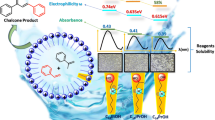Abstract
Halogenation (iodination and bromination) of various aromatic compounds has been studied in micellar media in order to observe the effect on regioselectivity and conversion of the reaction. The addition of surfactant causes a change in the chemical shifts of the aromatic proton resonance of phenol which proves the orientation of the aromatic compound on the micellar surface. However, increase in ionic strength of the reaction media affects the selectivity of reaction by disturbing this spatial orientation of the aromatic compound in the micelle. Selectivity towards particular isomers is dependent on the concentration of the surfactant. In bromination of chlorobenzene (deactivated aromatic compound) enhancement in selectivity and conversion towards the para isomer has been observed.
Graphical abstract



Similar content being viewed by others
References
Dwars T, Paetzold E, Oehme G (2005) Angew Chem Int Ed 44:7174
Wang F, Liu H, Cun L, Zhu J, Deng J, Jiang Y (2005) J Org Chem 70:9424
Witula T, Holmberg K (2005) Langmuir 21:3782
Samant BS, Saraf YP, Bhagwat SS (2006) J Colloid Interf Sci 302:207
Samant BS, Sukhthankar MG (2009) Med Chem 5:293
Samant BS (2008) Eur J Med Chem 43:1978
Hassan PA, Bhagwat SS, Manohar C (1995) Langmuir 11:470
Nagaonkar UC, Bhagwat SS (2007) Ind Eng Chem Res 46:1923
Samant BS, Sukhthankar MG (2011) Biorg Med Chem Lett 21:1015
Samant BS, Bhagwat SS (2011) Appl Catal A 394:191
Samant BS, Bhagwat SS (2011) Chinese J Catal 32:231
Samant BS, Kabalka GS (2011) Chem Comm 47:7236
Kleenmann A, Engel J (2001) Pharmaceutical substances, 4th edn. Thieme, New York
Vyas PV, Bhatt AK, Gadde R, Bedekar AV (2003) Tetrahedron Lett 44:4085
Patil BR, Bhusare SR, Pawar RP, Vibhute YB (2006) Arkivoc 1:104
Das B, Krishnaiah M, Venkateswarly K, Reddy VS (2007) Tetrahedron Lett 48:81
Kalyani D, Dick AR, Anani WQ, Sanford MS (2006) Org Lett 8:2523
Da Frota LCMR, Canavez RCP, da Silva Gomez SL, Costa PRR, da Silva AJM (2009) J Braz Chem Soc 20:1916
Hajipour AR, Falahati AR, Ruoho AE (2006) Tetrahedron Lett 47:4191
Jafarzadeh M, Hosseini A, Shokrollahzadeh M, Halvagar MR, Ahmadi D, Mohannazadeh F, Tajbakhsh M (2006) Tetrahedron Lett 47:3525
Gallo RDC, Gebara KS, Muzzi RM, Raminelli C (2010) J Braz Chem Soc 21:770
Ganguly NC, Barik SK, Dutta S (2010) Synthesis 9:1467
Firouzabadi H, Iranpoor N, Kazemi S (2009) Can J Chem 87:1675
Kiran YB, Konakahara T, Sakai NA (2008) Synthesis 15:2327
Kraszkiewicz L, Sosnowski M, Skulski L (2006) Synthesis 7:1195
Tee OS, Bennett JM (1988) J Am Chem Soc 110:269
Onyiriuka SO, Suckling CJ (1986) J Org Chem 51:1900
Iskra J, Stavber S, Zupan M (2004) Synthesis 11:1869
Podgorsek A, Zupan M, Iskra J (2009) Angew Chem Int Ed 48:8424
Stavber S, Jereb M, Zupan M (2008) Synthesis 10:1487
Tajik H, Dadras A, Hosseini A (2011) Synth React Inorg Met Org Nano Met Chem 41:258
Podgorsek A, Stavber S, Zupan M, Iskra J (2009) Tetrahedron 65:4429
Stavber G, Zupan M, Stavber S (2009) Synlett 4:589
Stavber G, Iskra J, Zupan M, Stavber S (2009) Green Chem 11:1262
Stavber G, Zupan M, Jereb M, Stavber S (2004) Org Lett 6:4973
Espenson JH, Zhu Z, Zauche TH (1999) J Org Chem 64:1191
Acknowledgments
We are grateful to Rhodes University Joint Research Committee (JRC) for providing financial support for this work (Rhodes University JRC grant number 35047).
Author information
Authors and Affiliations
Corresponding author
Electronic supplementary material
Below is the link to the electronic supplementary material, which includes 1H NMR spectra for the solubilization study of phenol.
Rights and permissions
About this article
Cite this article
Samant, B.S., Bhagwat, S.S. Selectivity enhancement of aromatic halogenation reactions at the micellar interface: effect of highly ionic media. Monatsh Chem 143, 1039–1044 (2012). https://doi.org/10.1007/s00706-011-0677-1
Received:
Accepted:
Published:
Issue Date:
DOI: https://doi.org/10.1007/s00706-011-0677-1



